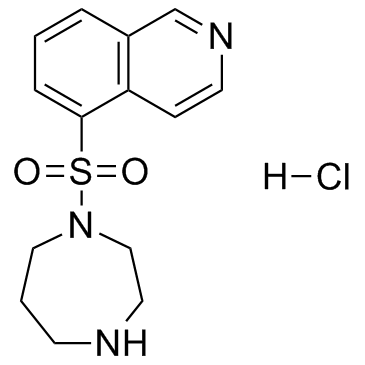ATC code C04AX32 (WHO) CAS Number 103745-39-7 Molar mass 291.36 g/mol | Metabolites PubChem CID 3547 | |
 | ||
AHFS/Drugs.com International Drug Names Biological half-life 0.76 hours. Active metabolite (hydroxyfasudil) 4.66 hours. | ||
How to pronounce fasudil
Fasudil (INN) is a potent Rho-kinase inhibitor and vasodilator. Since it was discovered, it has been used for the treatment of cerebral vasospasm, which is often due to subarachnoid hemorrhage, as well as to improve the cognitive decline seen in stroke victims. It has been found to be effective for the treatment of pulmonary hypertension. It was demonstrated in February 2009 that fasudil could improve memory in normal mice, identifying the drug as a possible treatment for age related or neurodegenerative memory loss.
Contents
It is approved for use in Japan and China, but has not been approved by the United States Food and Drug Administration or by the European Medicines Agency.
Molecular mechanism
Fasudil (HA-1077) is a selective RhoA/Rho kinase (ROCK) inhibitor. ROCK is an enzyme that plays an important role in mediating vasoconstriction and vascular remodeling in the pathogenesis of PH. ROCK induces vasoconstriction by phosphorylating the myosin-binding subunit of myosin light chain (MLC) phosphatase, thus decreasing MLC phosphatase activity and enhancing vascular smooth muscle contraction.
ACE expression
Angiotensin-converting enzyme (ACE) is an enzyme that catalyzes the conversion of angiotensin-I (Ang-I) to angiotensin-II (Ang-II). Ang-II is a peptide hormone which increases blood pressure by initiating vasoconstriction and aldosterone secretion. ROCK increases ACE expression and activity in PH. By inhibiting ROCK with fasudil, circulating ACE and Ang-II are reduced, leading to a decrease in pulmonary vascular pressure.
eNOS expression
Endothelial nitric oxide synthase (eNOS) mediates the production of the vasodilator nitric oxide (NO). Pulmonary arterial cell cultures treated with fasudil showed a significant increase in eNOS mRNA levels in a dose dependent manner, and the half-life of eNOS mRNA increased 2-folds. These findings suggested that ROCK inhibition with fasudil increases eNOS expression by stabilizing eNOS mRNA, which contributed to an increase of NO level to enhance vasodilation.
ERK activation
The proliferative effects of ROCK on vascular endothelial cells is due to the activation of extracellular signal-regulated kinase (ERK). ERK mediates cell proliferation via the phosphorylation of p27Kip1, thus accelerating the degradation rate of p27Kip1. p27Kip1 is a cyclin-dependent kinase (CDK) inhibitor which down-regulates cell cycle by binding cyclin-CDK complex. Human pulmonary arterial smooth muscle cells treated with fasudil showed a decrease in cell proliferation in a dose-dependent manner. Fasudil also decreases ERK activities, as well as increases level of p27Kip1. This suggested that the anti-proliferative effects of fasudil is due to the decrease of ERK activities via the inhibition of ROCK.
